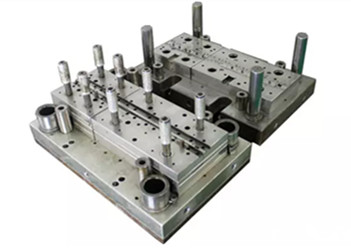A brief introduction of mold steel
Last article, we have introduced the “Tool Steel Grades Definition System”. As we all know, tool steels can be classified to many different types according to different standards. According to their detail application, tool steels can be divided into cutting tool steels, mold steels and gauge steels. Here we introduce the classification of mold steel.

-
Cold working mold steel
Cold working mold steel is mainly used to manufacture the mold for pressing the workpiece under cold condition, such as cold stamping mold, cold stamping mold, cold drawing mold, stamping mold, cold extrusion mold, thread pressing mold and powder pressing mold. Cold working mold steels range from carbon tool steels, alloy tool steels, high speed tool steels to powder and powder high alloy tool steels.
-
Hot working mold steel
Hot working mold steel is mainly used to manufacture the dies for pressing the workpiece under high temperature as hot forging die, hot extrusion molded, die-casting mold, hot heading mold and so on. The commonly used hot working mold steels are: medium-high carbon content with Cr, W, Mo, V and other alloying elements added alloy mold steels; High alloy Austenitic heat resisting mold steel or heat working die steel for special requirements.
-
Plastic mold steel
Different kinds of plastics have different requirements on the properties of plastic mould materials. Many developed countries have specified the use range of plastic mold steel series, including carbon structural steel, carburized type plastic mold steel, hard plastic mold steel, age hardening plastic mold steel, corrosion resistant plastic mold steel, free cutting hardened plastic mold steel, the whole model of plastic mold steel, the maraging steel and mirror polishing with plastic mold steel, etc.
Steel requirements for different molds:
Generally, the mold is divided into five grades according to the service life. The first class is above one million times, the second class is between 500,000 and one million times, the third class is between 300,000 and 500,000 times, the fourth class is between 100,000 and 300,000 times, and the fifth class is below 100,000 times.
The steel material for first and second class mold that can be heat treatment and hardness can be up to HRC50 or so, otherwise the mold are easy to wear and injection molding product qualification rate is poor, so the choice of steel not only have better heat treatment performance but also have good cutting performance in the state of high hardness, that depends other problem should to be taken the consideration. Usually choosing Sweden 8407, S136, the United States 420, H13, Europe 2316, 2344, 083, or Japan SKD61, DC53 (the original metal mold materials, special circumstances use).
But for that strong corrosive plastics generally selected S136, 2316 420 steel, in addition to S136, 2316 420, SKD61, NAK80, PAK90, 718M for that with weak corrosion. The appearance requirements of the product will influence the choice of mold materials. For the transparent parts and the products with the surface requirements of the mirror surface, the available materials including S136, 2316,718s, NAK80, PAK90, 420. For the molds with extremely high transparency, S136 should be selected, followed by 420. There are many pre-hard materials for the third class mold, material like S136H, 2316H, 718H, 083H with the HB hardness between 270 to 340. P20, 718,738,618,2311,2711 are used for the fourth-class and fifth-class molds, and S50C, 45# steel may be used for the molds with extremely low requirements, that is the mold cavity is made directly on the mold blank.
Attachment: various countries steel codes:
- AISI Code:
P1-P19:LowCarbon Steel
P20-P39:Low Carbon, High Alloy Steel(Plastic mould steel)
2XX,3XX,4XX,6XX:Stainless Steel
H1-H19:Chromium base (Hot working steel)
Wx:Water Hardening Steel
Sx:Shock Resisting Steel
Ox:Oi lHardening Steel
Ax:Air Hardening Steel
Dx:High Carbon, High Chromium Steel
Mx:Molybdenum base (H.S.S)
- DIN Code:
1.2738:Low carbon, high alloy (P20 – Plastic mould steel)
1.2311:Lowcarbon, high alloy (P20 – Plastic mould steel)
1.2312:Lowcarbon, high alloy, free Machine (P20-free cutting)
1.2083:StainlessSteel (420 – Acid resistant steel)
1.2316:High performance stainless Steel (420 – High acid resistant steel)
1.2343:Chromiumbase (H11–hot working steel)
1.2344:Chromiumbase (H13–hot working steel)
1.2510:Low alloy steel (O1- Oil steel )
1.2379:High carbon, high chromium steel
- JIS Code:
SxxC:Plain Carbon steel
SUSxx:Stainless Steel ( Acid resistant steel- 420)
SCrx:Chromium Steel
SCMx:Chromium Molybdenum Steel(P20)
SKx:Carbon Tool Steel
SKSx:Low Alloy Steel (Oil steel – O1)
SKD11:Medium-High Alloy Steel(D2)
SKD6:Medium-High Alloy Steel(H11)
SKD61:Medium High Alloy Steel(H13)
SKHxx:High Speed Steel (M 2)
SUMx:Free Cutting Steel
SUJx:Bearing Steel


